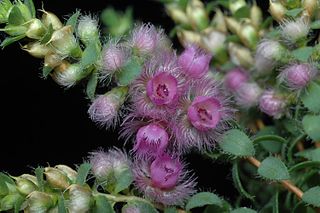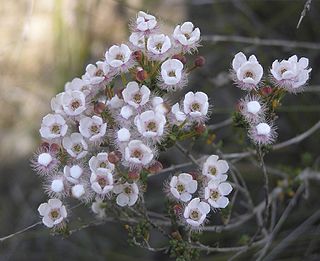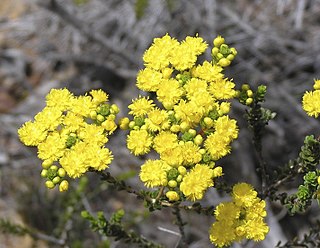
Verticordia blepharophylla is a flowering plant in the myrtle family, Myrtaceae and is endemic to the south-west of Western Australia. It is an erect, open shrub with a single main stem, leaves with hairy margins and pale to deep mauve-pink flowers and which occurs in an area between Perth and Geraldton.
Verticordia brachypoda is a flowering plant in the myrtle family, Myrtaceae and is endemic to the south-west of Western Australia. It is an irregularly branched shrub with narrow leaves crowded on side-branches, and cream-coloured or white flowers with pink, cream or white centres.

Verticordia cunninghamii, commonly known as tree featherflower or liandu, is a flowering plant in the myrtle family, Myrtaceae and is endemic to an area in the extreme north of Western Australia and the Northern Territory. It is a spindly shrub or small tree with narrow leaves and cream to white, sweetly scented, feathery flowers.

Verticordia habrantha, commonly known as hidden featherflower, is a flowering plant in the myrtle family, Myrtaceae and is endemic to the south-west of Western Australia. It is a slender shrub with short, leafy side-branches and long flowering stems with rounded heads of mostly white flowers. Its hairy sepals are mostly hidden by the round, unfringed petals, and as a result, the plant looks like shrubs in the genus Chamelaucium, to which it is closely related.
Verticordia sect. Verticordia is one of eleven sections in the subgenus Verticordia. It includes eight species of plants in the genus Verticordia. Plants in this section are open to bushy shrubs up to 1 m (3 ft) tall with needle-like leaves, feather-like sepals and anthers opening by slanting pores. When Johannes Conrad Schauer described other subgenera in Verticordia, subgenus Verticordia became an autonym after Augustin de Candolle who described the genus in 1828. When Alex George reviewed the genus in 1991, he took the name of this section from that of the subgenus.
Verticordia sect. Chrysoma is one of seven sections in the subgenus Chrysoma. It includes four species of plants in the genus Verticordia. Plants in this section are small shrubs with small, bright yellow flowers which usually turn red as they age. They have sepals with fringed lobes and petals which have lobes arranged like the fingers of a hand. The subgenus Chrysoma was originally described in 1843 by Johannes Conrad Schauer and the description was published in Monographia Myrtacearum Xerocarpicarum. When Alex George reviewed the genus in 1991, he took the name of this section from that of the subgenus.

Verticordia monadelpha is a flowering plant in the myrtle family Myrtaceae, and is endemic to the south-west of Western Australia. It is a much-branched shrub with pink to magenta flowers in spring and early summer. It is commonly known as pink Morrison, woolly featherflower, pink woolly featherflower, white woolly featherflower or pink cauliflower.

Homoranthus flavescens is a plant in the myrtle family Myrtaceae and is endemic to northern New South Wales. It is a low, spreading, flat-topped shrub with cylinder-shaped or flattened leaves. Single yellow to reddish flowers appear in leaf axils in late spring and summer, forming clusters near the end of the branchlets.
Verticordia densiflora var. cespitosa is a flowering plant in the myrtle family, Myrtaceae and is endemic to the south-west of Western Australia. It is a shrub with small leaves and pink, or pink and white flowers. It is one of five varieties of the species Verticordia densiflora.

Verticordia fimbrilepis, commonly known as shy featherflower, is a flowering plant in the myrtle family, Myrtaceae and is endemic to the south-west of Western Australia. It is a small, bushy shrub with one openly branched main stem at its base, small, pointed leaves and rounded groups of pink flowers near the ends of the branches.

Verticordia fimbrilepis subsp. fimbrilepis is a flowering plant in the myrtle family, Myrtaceae and is endemic to the south-west of Western Australia. It is a small bushy shrub with one openly branched main stem at its base, small, pointed leaves and rounded groups of pink flowers near the ends of the branches.

Verticordia lindleyi is a flowering plant in the myrtle family, Myrtaceae and is endemic to the south-west of Western Australia. It is sometimes an openly branched shrub, other times more or less dense, with small leaves and spreading, spike-like groups of pink or purple flowers along the stems in summer, sometimes also in autumn.

Verticordia serrata is a flowering plant in the myrtle family, Myrtaceae and is endemic to the south-west of Western Australia. It is a spindly or openly branched shrub with hairy, egg-shaped leaves and flowers which are golden at first, then fade to a greyish colour.
Verticordia sieberi is a flowering plant in the myrtle family, Myrtaceae and is endemic to the south-west of Western Australia. It is a shrub with one main stem, often compact but sometimes openly branched and with pink to pale purple flowers in summer and autumn.
Verticordia sect. Catocalypta is one of eleven sections in the subgenus Verticordia. It includes seven species of plants in the genus Verticordia. Plants in this section are small, bushy shrubs which grow to a height of up to 1 m (3 ft), have thick, fleshy, leaves which are triangular in cross-section. The flowers are arranged in open, corymb-like heads of relatively large flowers. Importantly, their sepals have down-turned, tufts of hair which surround the floral cup.

Calytrix angulata, commonly known as yellow starflower, is a species of plant in the myrtle family Myrtaceae that is endemic to Western Australia.
Calytrix brownii, commonly known as the white turkeybush, is a species of plant in the myrtle family Myrtaceae that is endemic to Western Australia.
Calytrix decandra, commonly known as the pink starflower, is a species of plant in the myrtle family Myrtaceae that is endemic to Western Australia.

Calytrix glutinosa is a species of plant in the myrtle family Myrtaceae that is endemic to Western Australia.

Calytrix sapphirina is a species of plant in the myrtle family Myrtaceae that is endemic to Western Australia.











